Basic Inquiry 40 Years
Vancouver Life Drawing Society
Celebrates
Forty Years
Researcher & Writer - Janet Nicol
Graphic & Web Design - Grandy C.
Cover art - Harvey Chan
Chapters

A Life Drawing Session
at Basic Inquiry

Twenty artists encircle a raised platform inside a spare, windowless studio on Vancouver’s East Side. Some are seated astride drawing benches, a few at easels. All hold an artist’s tool—charcoal, Conté stick, pencil—ready to mark the paper. A 40-something male model enters the room as the session manager announces the sequence of timed poses. The model steps onto the platform, disrobes under bright ceiling lights, and strikes a boxer’s stance. Quickly the artists—some inexperienced, some seasoned—begin drawing his naked form. A timer goes off and the model moves into another pose.
And so it goes for the three-hour session at Basic Inquiry.
I. The Origins of the Dream
One evening over a beer in Gastown, Gerald Kelly (1945-2001), a sculptor and industrial painter by trade, confided a dream to a group of friends. “I had everything I wanted, except a studio,” he told a Vancouver Sun reporter.
Gerry envisioned a space along the lines of New York’s Art Students’ League, where people could draw or sculpt a nude model in comfortable surroundings. Considering most life drawing spaces in Vancouver—and elsewhere—were attached to an art institution or community centre, setting up an independent, non-profit studio offered a unique experience for both artists and models.
In 1983, Gerry’s dream was realized. Along with a small group of artist friends, he rented a studio on the ground floor of 901 Main Street, next to the Georgia viaduct. Gerry established daily sessions for artists at $5 a ticket, with the additional option of purchasing an annual membership. He set up a roster of about 30 models. All monies went to the studio rent and model’s fee.
Maurice Spira, an artist and good friend of Gerry’s, came up with the name, Basic Inquiry. “Life drawing is a basic inquiry into the human form,” Maurice believed.
“Gerry loved it, straight out,” Maurice remembers. “He was the originator and organizer of Basic Inquiry. He knew how to set it up and get it going.”
Soon after sessions got started, Maurice moved to Roberts Creek, where he continues to reside—and where he ran a life drawing studio for more than 30 years.
Roy MacQueen heard about Basic Inquiry while attending a portrait drawing session at the Carnegie Centre, at Main and Hastings Streets. The studio had only been opened two weeks when Roy decided to drop in.
 Portrait of Gerry Kelly by Maurice Spira (1982). Photo credit: Derek von Essen.
Portrait of Gerry Kelly by Maurice Spira (1982). Photo credit: Derek von Essen.
“I remember there were about twenty people drawing there, sitting on crates,” Roy says. “Gerry was able to name each artist. I loved it.”
Roy became a regular, attending sessions right up to March, 2020, when the Covid-19 global pandemic struck. He recalls Gerry kept a record of each session in those early years, noting details such as the name of the model and number of people attending.
“I remember one or two artists who visited the studio from New York. They said there was nothing like it in the States.”
Susan Bates, an educational writer and illustrator, was a regular at Basic Inquiry and friend of Gerry’s. “There were the models,” she remembers, “Marketa from Eastern Europe, Josie, who was Italian and the voluptuous Catherine. Gerry liked to build community. When we first opened, he would start by introducing artists to each other. And then we would draw.”
“After Saturday sessions, we would all go out to lunch at a Portuguese hideaway across the street for pork chops and beer,” Susan recalls. “The food was inexpensive, ethnic, and delicious. The ambiance encouraged friendship and connection.”
 Storm, by Susan Bates. Photo submitted by artist.
Storm, by Susan Bates. Photo submitted by artist.
“Gerry was a gifted artist with his own unique style. He was technically skilled with a flowing confident stroke, employing circle effects over his drawings. I can’t be sure, but these gave the impression of target imagery.”
Keith Shields (1936-2009) was another founding member. A plasterer by trade, he trained as an artist in his youth. In the last 25 years of his life, he returned to art, devoting a substantial amount of time at Basic Inquiry. Keith’s bust of peace activist Kinuko Laskey—who was 16 when the atomic bomb fell on her home in Japan—was donated to the city of Vancouver and on permanent display at Seaforth Peace Park.
In 1988, Basic Inquiry registered as a non-profit organization named the Vancouver Life Drawing Society and set up a volunteer board to be elected annually from the membership. In 1991, the studio re-located—by choice—to the top floor of the same building. A rickety elevator with scissor gates transported artists and models five flights up. When a Vancouver Sun reporter paid a visit, she observed a large open studio containing old pop crates, a second-hand couch, a coffee pot, a stack of easels and paint-saturated pictures of nudes along the walls.
In 1993, the society qualified as a federal charity and that same year began publishing a quarterly newsletter. By 1994, Basic Inquiry had 500 members.
Derek Simons, an artist and retired Cultural and Social Planner at Vancouver City Hall, began dropping in for drawing sessions in the 1980s. “It was a welcoming place and I met interesting people,” he recalls.
When Gerry Kelly made the decision to leave Basic Inquiry for personal reasons, the responsibility for running the studio “fell into my lap,” Derek says. “There were sessions when no one turned up. I paid the model out of my own pocket.”
As more artists began showing up again, Derek worked out strategies to sustain the society. When the rental suite became available on the fifth floor, for instance, he saw re-location as an opportunity. “We could build a loft and there was more room for the artists,” he says.
Besides regular drawing sessions, the society offered three art courses per term. “We had a huge turn out,” Derek remembers. He credits part of the success to allowing students the option of purchasing a single ticket rather than committing to a whole term. “Most people ended up liking it and they took the full course.”
As compensation for his many hours operating the studio, Derek set up a separate space to work on his art and drew a modest salary. When he left in 1996, the society was in a strong financial position.
“Basic Inquiry is a good model for other creative groups,” Derek observes. “You’ve got a diversity of people, from college professors to tradesmen, total amateurs to sophisticated artists, and everything in between.”
The collective practice of drawing over a three-hour session is an equalizer, he says. “You are all sitting down and performing sustained, focussed work. There’s total silence. When there’s a coffee break and you talk to each other, you have common ground.”
Derek organized the Body Project with colleague Richard Pinet, organizing events such as performance works, lectures and visual art shows at venues across the city. The project was inspired by the principles of Basic Inquiry’s organizational model, Derek says, citing “meditation, equality and diversity.”
The society’s Annual Members Show, a tradition from the very beginning, features figurative art in the studio gallery. At the 12th Annual Members Show in 1997, 66 works were displayed by 39 artists.
 Call for Artists to celebrate Flamenco Dance, poster (2015). Photo credit: Bernie Lee.
Call for Artists to celebrate Flamenco Dance, poster (2015). Photo credit: Bernie Lee.
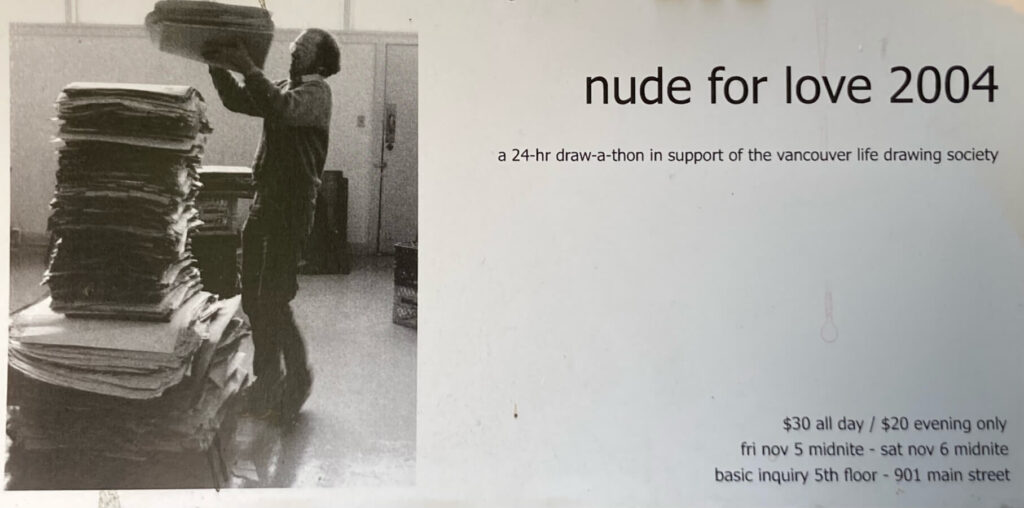
“It brought together Basic members in a kaleidoscopic show that was a true representation of our large and supportive membership,” the newsletter reported.
Individual and group exhibitions have showcased a wide range of work by local artists over the decades. Members’ initiatives have ranged from a Women’s Painting Group to collaborative workshops with the BC Clay Sculptors Society. Participation in events linked to the arts community has included Bravo Vancouver and the East Side Cultural Crawl.
Diverse professional models, male and female, and of different ages and body shapes, have posed at the studio. There have also been flamenco dancers, acrobats and athletes. Many models are also artists, including Lorna Schwenk and Steve Loxley. Lorna was a burlesque dancer for two decades, starting in the 1960s and later pursued a career as a massage therapist. In the 1990s Lorna modelled at Basic Inquiry.
“My background helped me to understand the body when I posed,” she says. And when Lorna looks through her own drawings from that time, she says “They are a reminder of how sketching from life is so very vital to me.”


Steve has been a full-time professional model for 40 years, posing at Basic Inquiry for the past 20 years. He was the first model to serve on the society’s board and says his early background as an athlete and photographic model, informs his work.
“I like artists,” Steve says about his choice of employment. “I’m comfortable around them.”
Eric Maddoux was an active member at Basic Inquiry for 18 years when he organized a unique fundraiser in 2004 along with professional model, Peter Read. For a $30 admission fee, artists participated in a 24-hour drawing marathon. Models took turns posing for artists in three hour shifts from 10am to 5pm. After a three hour break, the models gathered on three different stages and posed from 8pm to midnight. It was an unforgettable event for everyone involved.
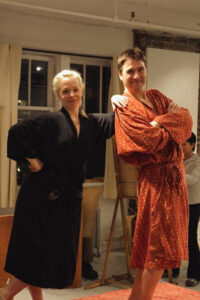 Models Steve Loxley and Bonny Giroux getting ready to pose. Photo credit: Alun Macanulty
Models Steve Loxley and Bonny Giroux getting ready to pose. Photo credit: Alun Macanulty
II. The Move to False Creek
The threat of building demolition at 901 Main Street weighed on members’ minds for several years, as reported in the newsletter. When the landlord gave an eviction notice in 2005, Basic Inquiry made a transition to the False Creek neighbourhood, renting a suite on the top floor of a brick building at 460-380 West 1st Avenue (and Wylie Street). An old freight elevator carried members to the spacious corner unit where natural light streamed in through windows and a skylight.
Chris Dunnett, a professional artist in Port Moody, was an active member at Basic Inquiry at both the Main Street and False Creek locations. “When I started in 2000, people were talking about moving,” Chris recalls.
Parking had become an issue due to vandalism and the building was not well-maintained, he remembers. Heating in the winter months was so inadequate; models sometimes wore mitts and hats when they posed. “There were too many problems and the numbers (of artists) were not increasing.”
“Members with full time jobs worked in the studio until midnight sometimes,” Chris says about the early days at the False Creek studio.
Alun Macanulty built drawing horses and a desk—furniture still in use at Basic Inquiry today. Walls with sliding rails facilitated a quick switch from studio to gallery. “People swarmed in,” Chris recalls. “I remember someone said it was like Coney Island. There were so many people in the studio.”
“No one has taught me more about art than the people at Basic,” Chris says. “How to see art and how to see the world. Drawing is really about the nakedness of looking at the world as it exists rather than as you think it exists.”
 Female figure (2014) by Merry Meredith. Photo submitted by artist.
Female figure (2014) by Merry Meredith. Photo submitted by artist.
The first show in the False Creek studio featured the work of Merry Meredith, a Graphics Designer and member of Basic Inquiry since the 1990s. Employing the use of an Etch A Sketch, a popular children’s toy of the 1960s, Merry depicted people she knew performing an enjoyable activity, each drawing executed in one continuous line. Patrons were enchanted, media attention was extensive and most of the 30 Etch A Sketch pieces sold.
Merry says figure drawing for her, is the most challenging and interesting of all art forms. “Dynamic short poses are a race to capture and longer poses give you more time to explore detail. Most people viewing the art can tell if a drawing is off. To succeed is exhilarating.”
 Cake First, An Etch A Sketch Drawing by Merry Meredith. Photo submitted by artist.
Cake First, An Etch A Sketch Drawing by Merry Meredith. Photo submitted by artist.
Karen Suk, now a social worker residing in Hamilton, started attending Basic Inquiry at the False Creek location. She describes the former studio as “beautiful.”
“I remember Ban Wei. He did Brush paintings on rice paper and would fill pages with figures. I’ve got two of his works on my wall now.”
Karen liked to attend the “long-pose” session on Friday nights. Besides painting figures in oils and acrylics, she made monoprints—painting on to Plexiglas, followed by applying soaked wet paper and pressing the image with a spoon, then pulling the print.
“I found my niche curating gallery shows,” Karen says about her volunteer contribution. She remembers In Three Parts. Each artist submitted three canvasses— a head, torso and legs. The canvasses were scrambled and the new figures displayed on the gallery wall. A limited edition book was also produced.
Exhibition openings are important, Karen believes, because they bring people together.
“There would be an opening night party. We’d get a liquor license and have food and music. When it was over, we’d close the doors and keep the party going.”
The fate of the False Creek studio turned out to be short-lived as the neighbourhood came under re-development for the 2010 Winter Olympics. Members began searching once again, for a studio to rent.

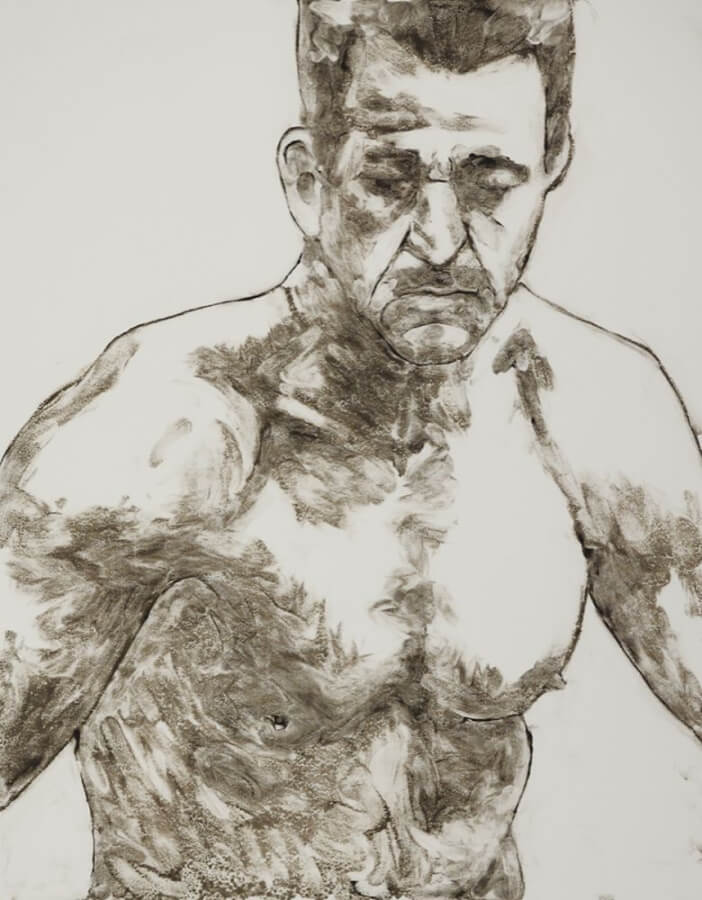
III. Back to Main Street
A deli once operated on the ground floor at 1011 Main Street. In 2007, Basic Inquiry acquired a five year lease from the City of Vancouver to rent the space. Peter Loebel, an artist and instructor now residing in Victoria, was on the board and played an instrumental role finding the location and initiating the move.
Paula Sawadsky attended Basic Inquiry since she was fifteen years old, back when Gerry was session manager. On moving day, she was part of the coordinated effort as a board member. “We had many volunteer assistants,” Paula remembers, “and even those with no special construction skills provided a helping hand and more importantly, moral support.”
 People Practise, flyer (2010) Painted by Paula Sawadsky. Photo submitted by artist.
People Practise, flyer (2010) Painted by Paula Sawadsky. Photo submitted by artist.
“So many people came out to help. It was overwhelming and really affecting to see people of all ages. There were Basic members and models alike, with gloves and work shirts and moving easels, drawing boards and kitchen stuff…”
“I learned from those years that community really can come out of volunteering with a group. Basic is a great Vancouver institution and I hope the city knows it is fortunate.”
The studio has continued to hum with artistic activity since the move to 1011 Main. As more animation studios became established in Vancouver, animator employees attended sessions, contributing to the society’s growth.
In 2008, a tip jar was instigated for the models. “Tipping is your opportunity to acknowledge the exceptional professionalism shown by many of our models,” the newsletter stated.
Suzanne Saint Pierre is a retired real estate agent with a long-held passion for art. She’s been a regular at Basic Inquiry since 2010, serving on the board and exhibiting her work on the studio walls.
 Pastel drawing of female by Suzanne Saint Pierre (detail). Photo submitted by artist.
Pastel drawing of female by Suzanne Saint Pierre (detail). Photo submitted by artist.
“I have a curiosity about people. I try to capture the personality and energy,” she says. “Having the whole body exposed is a way to have more information about the person. The way the models hold themselves. The gestures. The movements.”
Saint Pierre has met artists visiting from other parts of the world, including China, Taiwan, and Puerto Rico. “People find Basic Inquiry,” she observes. “It’s a small, comfortable group. They keep coming back.”
“It’s not about making money,” professional artist Ezra Larsen says. “It’s encouraging the artistic community in the pursuit of drawing nudes.”
Ezra has been honing his drawing skills at the studio since graduating high school more than a decade ago. He has also volunteered as a session manager and worked as a paid model. His father attended sessions at the original location. Ezra emphasizes the society’s welcoming atmosphere—past and present.
Basic Inquiry’s archived exhibition posters provide evidence of the talented artists who have come through the studio. Starting in 2010, the society website has posted detailed memorials of notable members who passed away, including Betty Woo (1943-2019) and Ingeborg Rayner (1922-2015).
‘Art for art’s sake’ has been a satisfying philosophy for many amateur members, as they benefit from the inspiring studio atmosphere. While independent learning is practised at drawing sessions, various forms of instruction have also taken place over the years. Sixty art students enrolled in Vancouver’s Churchill and Tupper Secondary Schools have visited the studio, for example, and so have public school art teachers on Professional Development days.


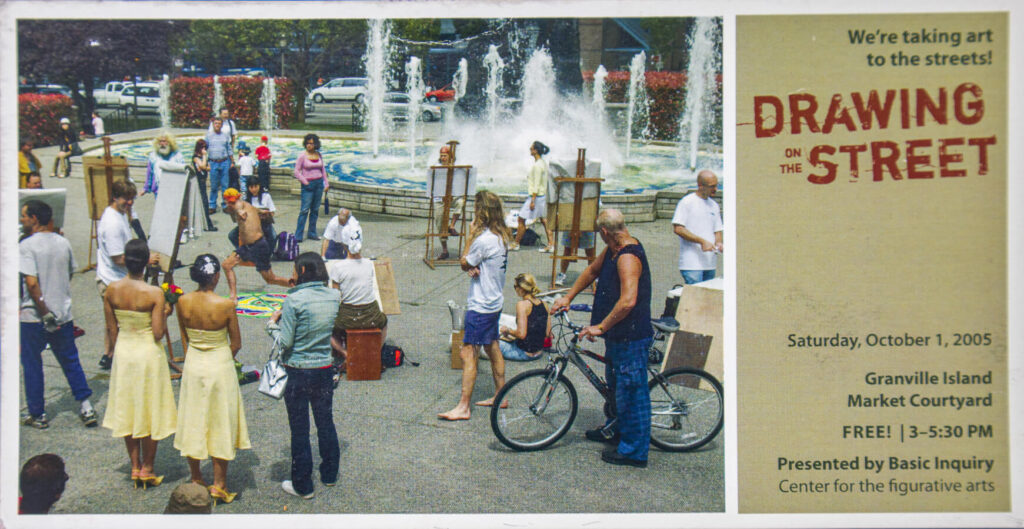
The society has also reached out to the community through a host of other organized activities. For a time, draped model sessions were conducted at St. Vincent’s Langara Hospital, an eldercare facility in south Vancouver. A Drawing on the Street event outdoors at Granville Island and the Vancouver Art Gallery involved members sketching draped models as passersby watched. Life drawing sessions at the Roundhouse Community Centre were offered twice weekly.
Fundraising has been on-going. For a time, Buddha Boards— Zen-like brush drawing tablets—were sold to members to raise money. The popular event, In the Nude, saw models posing, semi-draped and nude, for several hours. Funds have also been raised selling calendars illustrated with members’ figure drawings.
Recently, the society was in a position to give back to the community when a member who passed away made a substantial donation. The board set up a five year art student scholarship called the W.L. Davis Memorial Fund in collaboration with the Emily Carr University of Art and Design.



IV. Into the Future
The computer age has impacted the operation of the society, coupled with the lengthy Covid-19 pandemic. Douglas Smardon, at the helm of Basic Inquiry for the past 14 years, says the board looked at innovative ways to stay open during the pandemic.
 Douglas Smardon opening champagne at a members show. Photo credit: Alun Macanulty.
Douglas Smardon opening champagne at a members show. Photo credit: Alun Macanulty.
Board Member Ron Bijok organized an early form of electronic payment by e-transfer. During deep lockdown, Board Member Nicholas Jackiw and long-term model Chieh Huang pioneered some of the first live-streamed life-drawing sessions anywhere, in what became the very vibrant “Basic Inquiry Online” project and (online) community. Nick also developed the Robostrar software which eventually supported the studio’s re-opening by offering Basic Inquiry the possibilities of contact tracing, cashless payments, and capacity-controlled seating for the first time. This system remains in place today.
Post-pandemic, members continue to access the on-line registration system, in lieu of the former method of purchasing paper tickets. Each session is limited to 20 artists, after years of allowing for last-minute drop-ins leading to standing room only in the studio. Models book their sessions on line through
Robobooker. While the studio gallery continues to be an active space to display art work, many members have the additional option of social media platforms—including Basic Inquiry’s Facebook page.
 Alain Boullard enjoying a glass of wine at an opening show. Photo credit: Alun Macanulty.
Alain Boullard enjoying a glass of wine at an opening show. Photo credit: Alun Macanulty.
Alain Boullard has seen the shifts in the organization since joining Basic Inquiry in 2005. An architect artist by profession, Alain also served on the board during the pandemic. “It’s like a family,” he says of Basic Inquiry. “We have had our conflicts and our fun.”

He remembers the after-parties at the False Creek studio, following gallery openings. As for the computer age, he sees the positives—and negatives. He fondly recalls having the task of phoning models to book sessions and in doing so, getting to know them.
Daniel Ding has been employed at animation studios since graduating Capilano University six years ago. During his high school days in Burnaby, he attended Basic Inquiry on the recommendation of an art teacher. Now he’s back to practise his drawing skills.
“There’s a fear technology will make traditional drawing less relevant,” Daniel says. “I noticed my skills were decreasing doing [animation] design. Real-life drawing is more unforgiving if you make a mistake. You have to start over or fix it. It’s good training.”
Ultimately, Ding sees the benefits of both the old and the new ways. “Live model drawing is important,” he says. “It inspires animation work.”
Occasionally an artist will arrive at a session equipped with an iPad and compatible drawing tool. But there’s something about putting charcoal marks on paper that continues to appeal. Forty years on, Basic Inquiry still has much to offer the
creative soul—and the arts community of Vancouver.
 Ezra Larsen as model and drawing by Ben Luckhart. Photo submitted by model.
Ezra Larsen as model and drawing by Ben Luckhart. Photo submitted by model.
Sources
1. Obituary, Gerald Michael Kelly, The Ottawa Citizen, July 28, 2001, C5.
2. ’Lives Lived’, Keith Shields, The Globe and Mail, October 14, 2009.
3. “At Long Last, An Art Studio That’s a Picture of Comfort,” by Elizabeth Godley. The Vancouver Sun, December 27, 1986. E3
4. “Studio devoted to nude drawing holds marathon,” by Yvonne Zacharias. The Vancouver Sun, November 3, 2004, C5.
5. “Etching a Sketch with a Continuous Line,” Amy O’Brien. The Vancouver Sun, November 8, 2005, C2.
6. YellowPages.ca, Basic Inquiry – Article submitted by Susan Bates.
7. Basic Inquiry newsletters, (1993-2007). On file at Basic Inquiry studio.
8. Basic Inquiry Board Minutes (2009 to 2023) available on line at lifedrawing.org Also on the website are a list of exhibitions (2005 to 2023) and Member Memorials/Obituaries (2011 to 2023).
9. Interviews with former and current members of Basic Inquiry, conducted by Janet Nicol, (May to July, 2023).
10. “At an East Side Vancouver Art Studio, Experts and Amateurs Share a Love of Life Drawing,” by Janet Nicol. Montecristo magazine (on-line), November 22, 2022.
Also see: DrawBridge: Drawing Alongside My Brother’s Schizophrenia by Joan Boxall (Caitlin Press, BC $24.95). A moving sister’s account about artist and Basic Inquiry member Stephen A. Corcoran (1948-2013).
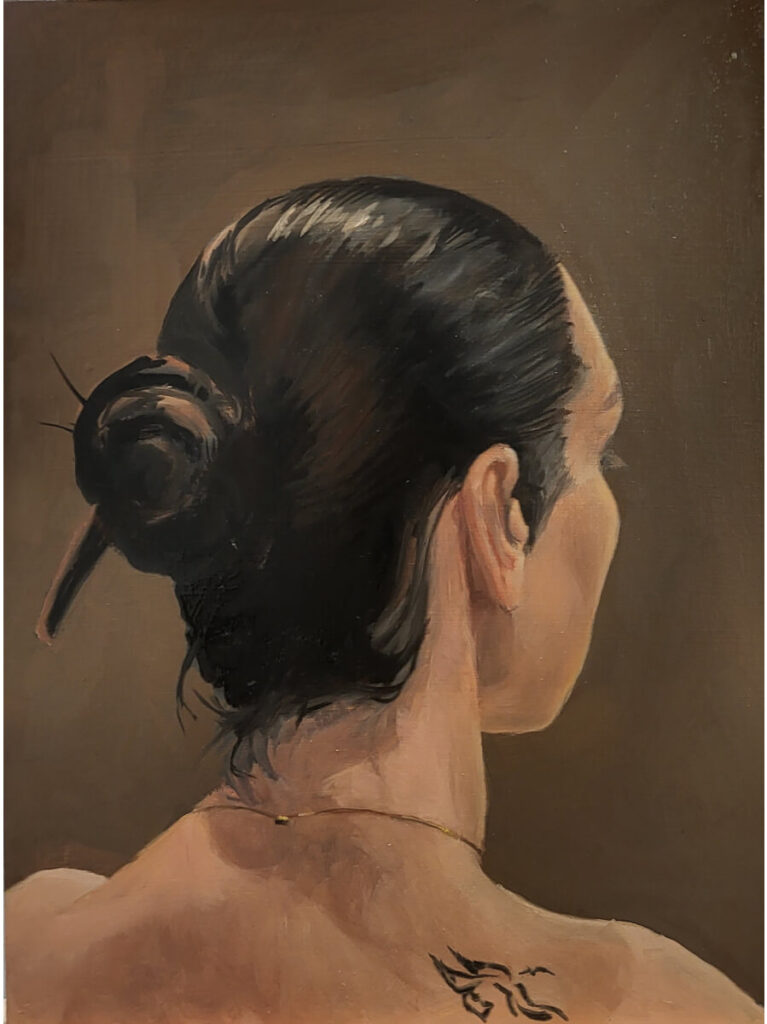
Vancouver’s Basic Inquiry Celebrates Forty Years
Acknowledgements
We acknowledge at our Studio that we gather on the traditional, ancestral, and unceded territory of the Coast Salish Peoples, including the territories of the xʷməθkʷəy̓əm (Musqueam), Sḵwx̱wú7mesh (Squamish), and səlilwətaɬ (Tsleil-Waututh) Nations.
Many thanks to the Basic Inquiry Board members (2022-23) approving this history project:
President – Douglas Smardon,
Treasurer – Nicholas Jackiw,
Member-at-large – Jaime T. Jones,
Director-at-large – Alain Boullard.
And thank you to the Board of 2023-24 for stepping up:
President – Kevin Hartwig,
Vice President – Bryce Baril,
Secretary – Lindsay Towns,
Treasurer – David Boal and,
Directors-at-large – Christian Geiser, Killian O’Reilly, Sarah Heng Hartse.
Credits
Researcher and Writer – Janet Nicol
Front Cover Art – Harvey Chan | Back Cover Art – Ron Bijok
Graphic Designer – Grandy C.
Proofreader – Joan Boxall
Publication funded by Basic Inquiry, The Vancouver Life Drawing Society
Keeping the Stories Alive...
Do you have a story or photographs to share about your time at Basic Inquiry?
Help us document the history of this vibrant community alive by sharing your story, memories, and photographs. A curated selection will be posted on this website.
Fill out the form to submit your story.